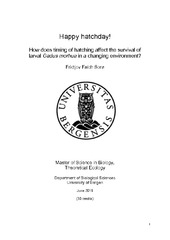Happy hatchday! How does timing of hatching affect the survival of larval Gadus morhua in a changing environment?
Master thesis
Permanent lenke
https://hdl.handle.net/1956/20367Utgivelsesdato
2019-06-22Metadata
Vis full innførselSamlinger
- Master theses [267]
Sammendrag
The classical match-mismatch hypothesis proposes that the timing between larval first feeding and food availability is an important driver of year-class strength. With climate change and the warming of the oceans, it is expected that the spring bloom in temperate waters will start earlier in the year, which may shift the timing of food availability for fish larvae, such as Calanus finmarchicus eggs and nauplii. However, decreased water clarity due to climate-driven run-off from terrestrial environments is hypothesised to have the opposite effect, delaying the spring bloom. Here, we present a mechanistic model of the propagation of C. finmarchicus eggs and nauplii together with dependent larval Gadus morhua growth, and include spring bloom timing, water clarity and visual predation mortality. The results suggest that decreased water clarity reduce visual predation on spawning Calanus, leading to increased egg and nauplii food for fish larvae. Increased food availability in addition to the reduced visual predation on cod larvae, may suggest that decreased water clarity increase larval survival at certain optimal spawning times. Due to the responses in larval fitness from decreased water clarity, we suggest that non-chlorophyll light attenuation is an important parameter to consider in future models of fish larvae.
